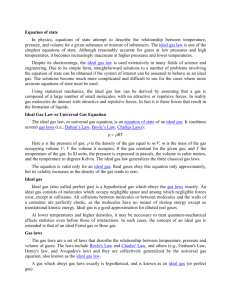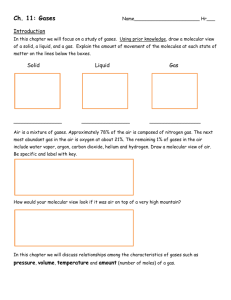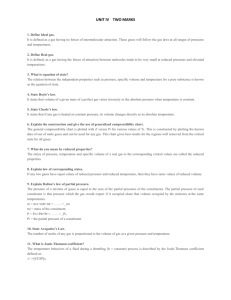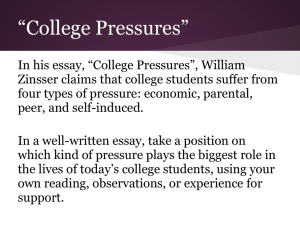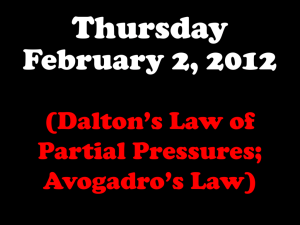CHEM_11.1ST
advertisement
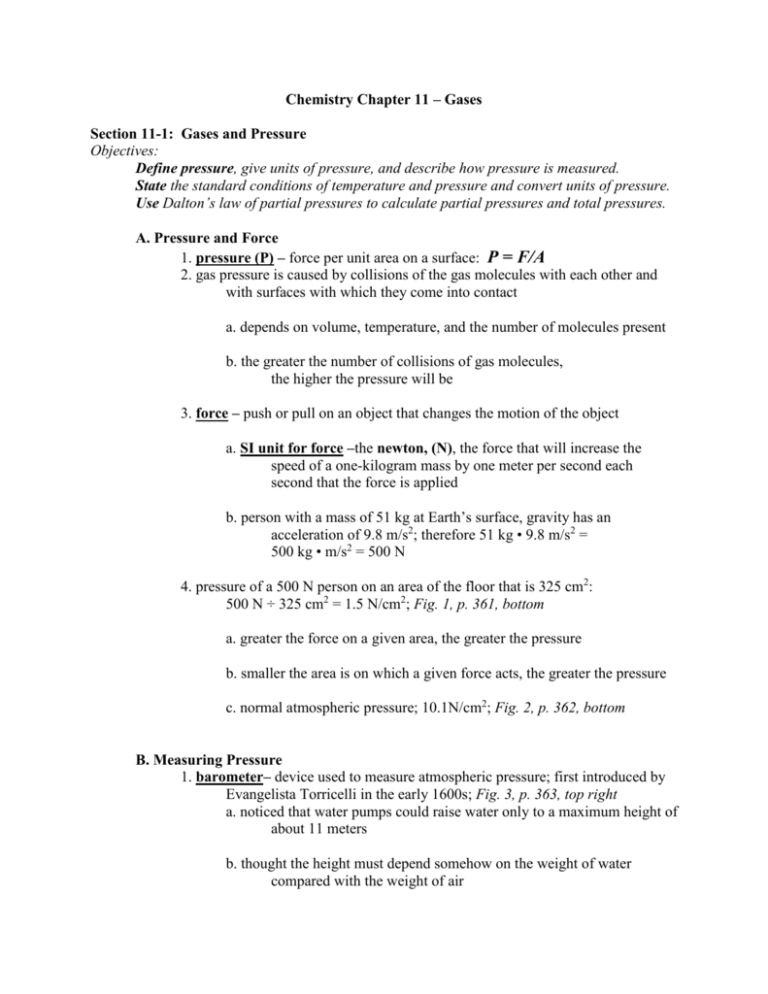
Chemistry Chapter 11 – Gases Section 11-1: Gases and Pressure Objectives: Define pressure, give units of pressure, and describe how pressure is measured. State the standard conditions of temperature and pressure and convert units of pressure. Use Dalton’s law of partial pressures to calculate partial pressures and total pressures. A. Pressure and Force 1. pressure (P) – force per unit area on a surface: P = F/A 2. gas pressure is caused by collisions of the gas molecules with each other and with surfaces with which they come into contact a. depends on volume, temperature, and the number of molecules present b. the greater the number of collisions of gas molecules, the higher the pressure will be 3. force – push or pull on an object that changes the motion of the object a. SI unit for force –the newton, (N), the force that will increase the speed of a one-kilogram mass by one meter per second each second that the force is applied b. person with a mass of 51 kg at Earth’s surface, gravity has an acceleration of 9.8 m/s2; therefore 51 kg • 9.8 m/s2 = 500 kg • m/s2 = 500 N 4. pressure of a 500 N person on an area of the floor that is 325 cm2: 500 N ÷ 325 cm2 = 1.5 N/cm2; Fig. 1, p. 361, bottom a. greater the force on a given area, the greater the pressure b. smaller the area is on which a given force acts, the greater the pressure c. normal atmospheric pressure; 10.1N/cm2; Fig. 2, p. 362, bottom B. Measuring Pressure 1. barometer– device used to measure atmospheric pressure; first introduced by Evangelista Torricelli in the early 1600s; Fig. 3, p. 363, top right a. noticed that water pumps could raise water only to a maximum height of about 11 meters b. thought the height must depend somehow on the weight of water compared with the weight of air 11.1b c. reasoned that if the maximum height of a water column depended on its weight, then mercury, which is about 14 times as dense as water, could be raised only about 1/14 as high as water d. tested this idea by sealing a long glass tube at one end and filling it with mercury. Inverting the tube into a dish of mercury, the mercury rose to a height of about 760 mm, which is about 1/14 of 11 meters 2. units for atmospheric pressure; Table 1, p. 364, bottom a. millimeters of mercury (mm Hg) – common unit of pressure; also called 1 torr in honor of Torricelli b. one atmosphere of pressure (atm) – exactly equivalent to 760 mm Hg; average atmospheric pressure at sea level at 0°C is 760 mm Hg c. pascal (Pa) – SI unit for pressure; defined as the pressure exerted by a force of one newton (1 N) acting on an area of one square meter; 1 Pa = 1 N/ m2 (1) very small unit of pressure, usually express pressure in kilopascals (kPa); 1 atm = 101.325 kPa (2) named for Blaise Pascal, a French mathematician and philosopher who studied pressure during the 17th century “There is a God shaped vacuum in the heart of every man which cannot be filled by any created thing, but only by God, the Creator, made known through Jesus.” 3. standard temperature and pressure; STP = 1 atm and 0o C or 273 K C. Dalton’s Law of Partial Pressures 1. partial pressure – pressure of each gas in a mixture; pressure exerted by each gas in a mixture is independent of that exerted by other gases present 2. Dalton’s law of partial pressures – the total pressure of a gas mixture is the sum of the partial pressures of the component gases PT = P1 + P2 + P3 … 11.1c D. Gases Collected by Water Displacement 1. Gases produced in the laboratory are often collected over water. The gas produced by the reaction displaces the water in the reaction bottle. Fig. 5, p. 366, top 2. apply Dalton’s Law of Partial Pressures to calculate the pressures of gases collected in this way a. water molecules at the liquid surface evaporate and mix with the gas molecules, exerting a vapor pressure b. determine the pressure of a gas inside a collection bottle applying Dalton’s law of partial pressures: Patm = Pgas + Pwater c. reading the atmospheric pressure from a barometer and looking up the value of water vapor pressure at the temperature of the experiment in a table, you can calculate pressure of the gas Sample Problem B
